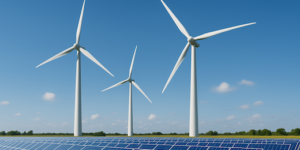The article titled “Climate goals: a priority for business growth” was written for the Dubai World Trade Centre, and published on 7th March 2021.
Climate goals: a priority for business growth
Reducing carbon emissions presents significant commercial opportunities for businesses across the Middle East. Dr Nasser H Saidi, chair of the MENA Clean Energy Business Council explores the future wins for companies ready to go green
It is clear that we are heading towards further temperature increases. As a result, the amount of methane is rising rapidly, exacerbated by melting polar ice caps, with Arctic sea ice alone declining at a rate of almost 13 per cent per decade, as estimated by the World Wildlife Fund. A consequence of this is rising sea levels, and in the MENA region this presents a challenge for many coastal cities.
Almost 90 per cent of our water is imported and, according to NASA, the region has been subject to an almost continuous drought since 1998. Here, in the GCC, we’ve also been rapidly depleting aquifer water which was historically used to establish agricultural self-sufficiency. Saudi Arabia, for example, has exhausted 40 per cent of aquifer water that had been accumulated over millennia, in just 15 years.
Challenges offset by opportunity
There are several positives, however, as green economies and green technology also bring significant opportunity, especially for the region’s business community. The impact of Covid-19 caused many companies to pause sustainability efforts, but with global policymakers pushing for a more sustainable post-pandemic economic recovery, it’s time to get back on track.
In essence, we need to move away from 50 years of highly energy intensive and fossil fuel-dependent activity and transition to renewable energy and associated technologies, led by the private sector in partnership with the public sector and local communities.
There are numerous ways that MENA-based companies can achieve this and increase profitability through emission reduction initiatives, beginning with greater energy efficiency. By analysing energy use, companies can determine how best to reduce energy consumption, which in turn means a reduction in operating costs.
The next step is to invest in renewable energy, whether it’s solar, wind or another geothermal solution, with the longer-term benefit being lower maintenance costs throughout the equipment lifecycle. There’s also a third benefit: lower health costs, with the replacement of fossil fuels reducing pollution.
From a technology perspective, over time the adoption of new technologies presents an opportunity to enter the green economy and gain a foothold through the development of new products and business streams. If we consider water shortages and regional reliance on desalination, for example, renewable energy has a vital role to play. An electricity-generating solar plant can also be used for desalination, so the MENA countries are well placed to become global leaders in desalination technology, which could then be exported globally.
Driving profitability through local production
Another regional advantage – and opportunity – is in the monetisation of our high levels of solar irradiation. Solar-generated electricity could be line exported through Egypt, or other countries, to Europe; and you could also establish power lines into India and Pakistan. As well as a commercial opportunity, this would also have a positive impact on pollution levels and companies would actively reduce their carbon footprint. Companies that develop a comparative advantage in renewable energy could take it a step further, by establishing a global export business for locally produced solar technologies.
The UAE and Saudi Arabia are at the forefront of renewable technology, with a number of companies already developing and installing solar technology, and the establishment of solar plants including Noor Abu Dhabi and the Mohammad bin Rashid Al Maktoum Solar Park, which give us access to the cheapest solar power in the world.
There is a need to accelerate investment and, in addition to the removal of fossil fuel subsidies to put prices on a global par, in my opinion the best way to do this would be to impose a carbon tax. If the carbon tax was set somewhere between US$50-70 per ton1, this would effectively raise more funds than currently yielded from VAT in Saudi and the UAE. If we then channelled carbon tax income and fossil fuel subsidies savings into renewable energy investment in the green economy, this could also help the private sector to make the switch, adopt clean technologies and transform transportation, the built environment and many other areas.
In time, this will also become part of foreign policy. The UAE, for example, is recognised for its foreign aid contribution; and part of that contribution could be renewable energy and technology based, targeted at poorer countries. So, instead of financial support, aid would be in the form of UAE-produced renewable energy and clean technology installations.
Unlocking capital through climate goal commitment
Sustainable finance is one area to watch as central banks, financial institutions and capital markets increasingly look to move away from financing and investing in fossil fuel assets. Norway’s sovereign wealth fund is divesting away from fossil fuel assets and is an excellent example of this developing trend. The trend will only accelerate as central banks, followed by financial institutions and capital markets, also introduce climate risk in asset and loan pricing. The upshot is that the cost of finance and capital will become more expensive for heavily energy or fossil fuel intensive companies.
Companies already pursuing sustainable operations will have a lower cost of credit plus easier and less costly access to capital markets. This means that the cost of credit and cost of capital through equity markets, or bond and sukuk markets, will decrease over time and encourage sustainable investment and climate risk mitigation technologies.
The green sukuk market is set to grow rapidly in the next few years with a recent S&P Global Ratings report noting that US$65 billion in sukuk bonds are set to mature this year, part of which is expected to be refinanced on the sukuk market. S&P estimates that total sukuk issuance will tally between US$140-155 billion in 2021, up from US$139.8 billion in 2020. In January 2021, First Abu Dhabi Bank, which is the country’s largest lender, raised just over US$292 million through its sixth green bond issuance. The Saudi Electricity Company (SEC) similarly raised US$1.3 billion in the region’s first dual-tranche green sukuk in 2020.
It’s here that governments are key. As they start to issue more green bonds and sukuk they set a benchmark for the private sector to do the same. So, to tie all the financing elements together, first, governments issue the bonds and, second, the capital markets set standards for green debt and equity, with the added responsibility (along with regulatory authorities) of monitoring potential green washing.
Plan of action
The opportunities are clearly there, but companies need a focused plan of action to take the sustainability agenda forward. First, they need to make sustainability part of company culture. They need to evaluate their operations, review their energy efficiency, analyse their carbon footprint and consider their role in pollution and environmental management. Then, they can integrate it into company culture.
In addition to sustainability awareness, this approach can also impact sustainable product development. For example, a company producing hugely polluting air conditioners could look into how it can reduce the amount of electricity its products require per unit of output.
Second, companies should consider R&D investments. What are they investing in to improve their products and business? And, third, companies should look at their engagement with the public sector. What does a particular country have in place in terms of a climate action plan? What role does a company’s industry sector play? What is the company’s role in that? For example, if a company is in the transport sector, it has a major part to play in the transition to electric vehicles and developing the transportation infrastructure for e-mobility.
Actions can hit roadblocks around the issue of incentives. A major short-term disincentive is a company’s quarterly or annual profitability goals, when the benefits of addressing climate change comes with a medium to long-term outlook and risk profile.
We have to remember that when I, as an individual or a company, pollute, I don’t pay the cost, everybody pays the cost. There is an externality to my actions which I do not pay for. So, the question is, how do you internalise those costs? This is where the issue of carbon pricing and the carbon tax is so important, because until we have these actions in place, businesses have zero incentive to address their own climate risk profile.
This goes hand in hand with the need to achieve greater energy efficiency across the board. The GCC countries use twice as much energy per unit of GDP, on average, as the OECD countries. Thankfully, Dubai Electricity & Water Authority and Abu Dhabi Water & Electricity Authority now provide detailed individual usage reports. We can use this type of digital information to increase awareness and price accordingly.
For the business community to meet strategic or mandated climate change goals it all starts with regional government and a national climate action plan with a clear strategy and rollout. Once this is in place then you know where you fit in as a business or individual and what you can do to drive profitability and support climate change goals. The bottom line is that we must act collectively and in a concerted manner to address and mitigate the existential threat of climate change.
1 A carbon tax of $40 per ton would add about 36 cents to the price of a gallon of gasoline for example.








